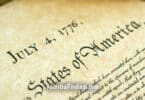The history of the U.S. Navy is longer than the history of the United States. It’s even longer than the idea of the United States.
Back in 1775, the Colonists (Americans) were fed up with their rights as part of the British Empire being trampled, so they decided to fight for those rights. The Continental Army took up arms against the British Army from Maine to Georgia.
However, there was one small problem: the British Navy. At the time, the British Navy controlled the seas and could easily ferry troops and supplies. It could also cut off any supplies or aid the Colonists could receive.
In this climate, on October 13, 1775, in Philadelphia, the Continental Congress voted to fit out two sailing vessels with crews and guns. Its mission: to intercept munitions ships supplying the British Army. That legislation created the beginning of what was to become the U.S. Navy.
Just like the challenge of creating a new nation, the birth of the U.S. Navy was not easy. Some members of Congress were hesitant to escalate the conflict, hoping to reconcile with Britain. That hesitancy seems strange because Congress had created the Continental Army, issued money to support the troops, and was working to establish relations with foreign countries.
Congress spent early October 1775 debating the possibility of creating an American fleet. The proposal on the table was to ask states to intercept British munitions ships and outfit two American ships. On October 13, Gen. George Washington sped up the passage of the measure with a letter informing Congress he had obtained three schooners at Continental expense to do just what the resolution on the table was asking. Two more wasn’t too much to ask because Washington was already sailing the ocean with Continental ships.
The U.S. Navy was born — nine months before the United States of America.
The birth of the U.S. Navy is a fascinating part of Revolution-era research. Genealogy records from the time would provide families with an interesting look into their bloodlines.
Learn More:






